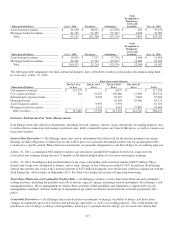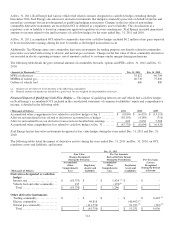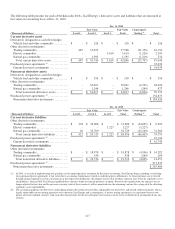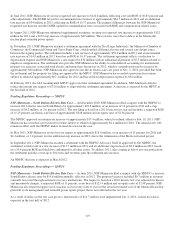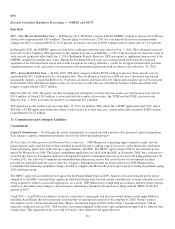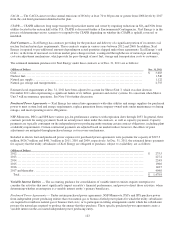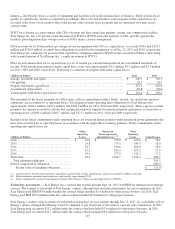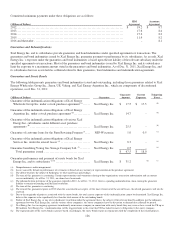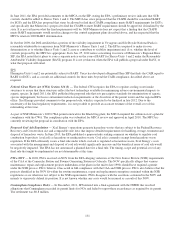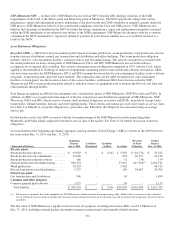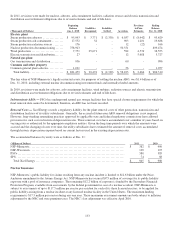Xcel Energy 2011 Annual Report Download - page 133
Download and view the complete annual report
Please find page 133 of the 2011 Xcel Energy annual report below. You can navigate through the pages in the report by either clicking on the pages listed below, or by using the keyword search tool below to find specific information within the annual report.
123
CACJA — The CACJA aims to reduce annual emissions of NOx by at least 70 to 80 percent or greater from 2008 levels by 2017
from the coal fired generation identified in the plan.
CSAPR — CSAPR addresses long range transport of particulate matter and ozone by requiring reductions in SO2 and NOx from
utilities located in the eastern half of the U.S. CSAPR is discussed further at Environmental Contingencies. Xcel Energy is in the
process of determining various scenarios to respond to the CSAPR depending on whether the CSAPR is upheld, reversed, or
modified.
Fuel Contracts — Xcel Energy has contracts providing for the purchase and delivery of a significant portion of its current coal,
nuclear fuel and natural gas requirements. These contracts expire in various years between 2012 and 2060. In addition, Xcel
Energy is required to pay additional amounts depending on actual quantities shipped under these agreements. Xcel Energy’s risk
of loss, in the form of increased costs from market price changes in fuel, is mitigated through the use of natural gas and energy
cost-rate adjustment mechanisms, which provide for pass-through of most fuel, storage and transportation costs to customers.
The estimated minimum purchases for Xcel Energy under these contracts as of Dec. 31, 2011 are as follows:
(Millions of Dollars) Dec. 31, 2011
Coal ...................................................................................................
$
3,683
Nuclear fuel............................................................................................
1,546
Natural gas supply ......................................................................................
1,122
Natural gas storage and transportation ....................................................................
2,755
Estimated coal requirements at Dec. 31, 2011 have been adjusted to account for Sherco Unit 3, which was shut down in
November 2011 after experiencing a significant failure of its turbine, generator and exciter systems. It is uncertain when Sherco
Unit 3 will recommence operations. See Note 5 for further discussion.
Purchased Power Agreements — Xcel Energy has entered into agreements with other utilities and energy suppliers for purchased
power to meet system load and energy requirements, replace generation from company-owned units under maintenance or during
outages, and meet operating reserve obligations.
NSP-Minnesota, PSCo and SPS have various pay-for-performance contracts with expiration dates through 2033. In general, these
contracts provide for energy payments based on actual power taken under the contracts, as well as capacity payments. Capacity
payments are typically contingent on the independent power producing entity meeting certain contract obligations, including plant
availability requirements. Certain contractual payments are adjusted based on market indices; however, the effects of price
adjustments are mitigated through purchased energy cost recovery mechanisms.
Included in electric fuel and purchased power expenses for purchased power agreements were payments for capacity of $325.3
million, $426.7 million and $461.3 million in 2011, 2010 and 2009, respectively. At Dec. 31, 2011, the estimated future payments
for capacity that the utility subsidiaries of Xcel Energy are obligated to purchase, subject to availability, are as follows:
(Millions of Dollars)
2012................................................................................................
.....
$
275.5
2013................................................................................................
.....
227.2
2014................................................................................................
.....
224.9
2015................................................................................................
.....
198.6
2016................................................................................................
.....
148.7
2017 and thereafter ................................................................
.......................
404.0
Total ................................................................................................
..
$
1,478.9
Variable Interest Entities — The accounting guidance for consolidation of variable interest entities requires enterprises to
consider the activities that most significantly impact an entity’s financial performance, and power to direct those activities, when
determining whether an enterprise is a variable interest entity’s primary beneficiary.
Purchased Power Agreements — Under certain purchased power agreements, NSP-Minnesota, PSCo and SPS purchase power
from independent power producing entities that own natural gas or biomass fueled power plants for which the utility subsidiaries
are required to reimburse natural gas or biomass fuel costs, or to participate in tolling arrangements under which the subsidiaries
procure the natural gas required to produce the energy that they purchase. These specific purchased power agreements create a
variable interest in the associated independent power producing entity.


